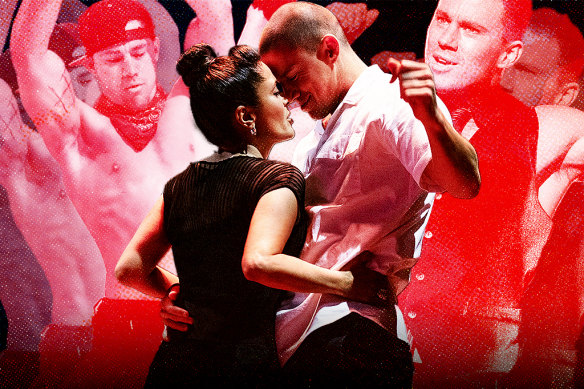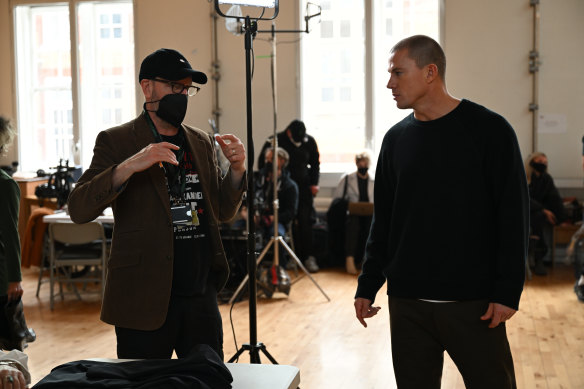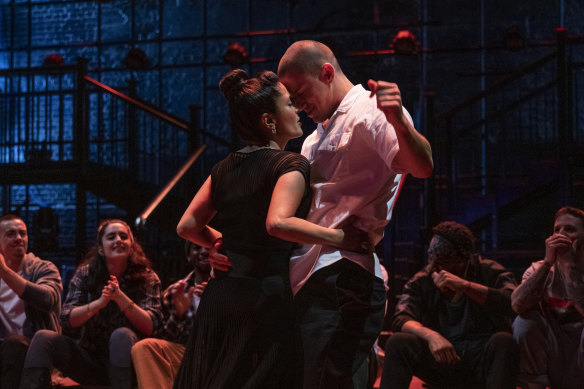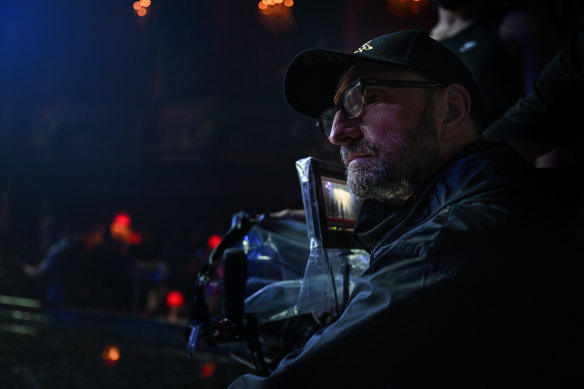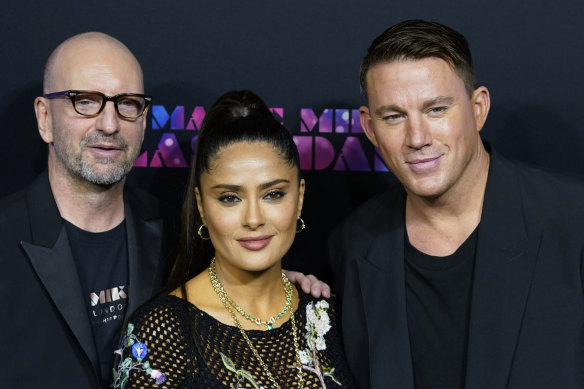By Osman Faruqi
Magic Mike has had his last dance – and it was a good one.
″This is where this thing’s either gonna kill us, or we’re gonna survive,” the Oscar-award winning director Steven Soderbergh told the leading man of his latest film, just before shooting its climactic scene. “This is Omaha Beach.”
The leading man was Channing Tatum, and though he has starred in his fair share of action movies, Soderbergh wasn’t directing him in a World War II film. The scene that one of Hollywood’s most prolific and acclaimed directors compared to the D-Day landings at Normandy was actually a dance number involving a shirtless Tatum, a lingerie-clad ballerina and thousands of litres of water.
It’s a stunning sequence that helps conclude the Magic Mike trilogy of films, each packed with their own breathtaking dance set pieces. The first two films in the series, Magic Mike and Magic Mike XXL have collectively made more than $400 million at the global box office, setting high expectations for the third, Magic Mike’s Last Dance, released in cinemas this week.
So how exactly did a film about a rag-tag group of strippers, stacked with a cast of relative unknowns including a retired wrestler, spawn a massively popular franchise that now includes not just three movies but a reality TV spin off, a global live show and a scene worthy of a World War II analogy? The origins, believe it or not, lie with this masthead.
In a 2010 interview with The Sydney Morning Herald, Tatum, then most well-known for his roles in dance movie Step Up and it’s sequel, as well as the reboot of GI Joe, shared publicly for the first time his intention to make a film based on his real-life experience as an 18-year-old stripper in Florida.
“It needs to be a crazy film and I think it’s also possible to do a cute, romantic movie,” Tatum said. “I’m going to be getting back in my thong again.”
Later that year the actor was filming Haywire, a thriller from Soderbergh.
“We were standing around on set, and I knew that he had a production and was trying to get stuff developed, so I said give me the laundry list of what you’re developing,” Soderbergh says. “The last one he mentioned, he kind of tossed it off like ‘Oh and then there’s this thing about when I was a stripper in Tampa.’
“And I went, ‘Wait a minute, what did you say? That’s gold. That’s like Saturday Night Fever. That’s a gigantic idea, don’t sit on it’.”
Director Steven Soderbergh and Channing Tatum on the set of Magic Mike.
Tatum took his advice and started working on the first iteration of what would become Magic Mike. A year later when the first director attached to the film pulled out, he called Soderbergh to ask if he still liked the idea.
“Yeah I like the idea,” Soderbergh says he told Tatum. “And you’re gonna meet me Saturday on Sunset Boulevard at this hot dog restaurant called Carneys and we’re going to talk about it.
“We agreed to make the movie and to finance it ourselves. I said I’d go to Cannes next month to sell [the rights] in enough territories to cover us, and we’re going to shoot it in September.
“It was born out of a ‘hell yeah’ reaction to Channing’s one line description”.
If that sounds like a slightly anarchic way to decide to make a major motion picture, welcome to the world of Steven Soderbergh. At 26, he made his directorial debut with Sex, Lies and Videotape which won the Palmes D’or at Cannes in 1989 and saw him hailed as a prodigy. He became a leading figure of American cinema’s independent revival in the 1990s, eschewing the traditional studio system and drawing inspiration from French New Wave directors of the 1950s such as Jean-Luc Godard.
In 1998, he directed Out of Sight, a heist film starring George Clooney and Jennifer Lopez. The film was critically acclaimed and a box-office hit, helping Clooney transition out of TV by cementing him as a Hollywood leading man. But it was at the 2000 Oscars that Soderbergh’s reputation as one of the greatest directors of his generation was truly cemented.
Salma Hayek plays Maxandra Mendoza, who lures Channing Tatum’s Mike to London to direct a stripping extravaganza.
He released two films that year: Erin Brockovich starring Julia Roberts and Traffic, the crime drama featuring a blockbuster ensemble cast. Extraordinarily, Soderbergh was nominated for an Academy Award for best director for both films, the first and only time such a feat has been achieved since 1938. He eventually won for Traffic, and made a hard pivot with his next film: the hugely popular Ocean’s 11, which brought together two of his previous collaborators in George Clooney and Julia Roberts.
In the two decades since, the prolific director has released 22 films, including two more Ocean’s moves, a two-part Che Guevara biopic starring Benicio Del Toro, the pandemic thriller Contagion, a sports drama on Netflix filmed entirely on an iPhone, and of course, the Magic Mike films.
The first Magic Mike film, released in 2012, follows Tatum and his crew of fellow dancers under the direction of Matthew McConaughey’s character Dallas, as they try to make ends meet and save up for a move out of Tampa Bay, Florida. While its most memorable scenes, rightly so, are those featuring a posse of almost-nude men dancing and grinding to RnB bangers while being showered in dollar bills by hundreds of excited women, there’s also a darker hue to the film.
Set in the aftermath of the global financial crisis, the movie is an unmistakeable condemnation of corporate capitalism, greed, and the betrayal of the American dream. Mike’s dancing is a means to an end: ownership of his own business, and liberation from the chains of wage-labour, but he is constantly manipulated and exploited by the forces around that wield more economic power – his boss Dallas, and the banks he is trying to secure a loan from to start his own furniture business.
Director Steven Soderbergh says Magic Mike has “evolved into a discussion about men and women and desire and freedom”.
While the dance set pieces are full of colour, light and vibrancy, Soderbergh’s vision of Florida is washed-out and grim. Even Mike’s love-interest is a Trojan horse for commentary on the parlous state of the privatised US healthcare system.
“I think people’s memories of the first film are probably different to the actual film itself,” Soderbergh says. “They’d be shocked when they go back and look at the first film and how dark it is. I mean, Mike opts out of a situation that he feels is either denigrating or not appreciative of his talent. And he feels somewhat betrayed, and just not good about the whole thing. The movie is really about him deciding, ‘I’m leaving all of that’.”
The second film, which Soderbergh didn’t direct but executive produced, drops some heavier themes and leans heavily into the exploration of female desire and pleasure.
“We wanted more dancing, more humour, and more exploration of the unspoken contract that exists in this specific context of what used to be a strip show.”
The third is another evolution, inspired by Soderbergh’s experience of watching the live Magic Mike stage performance, a strip show cabaret designed by Tatum himself, aimed at giving audiences a real-life taste of the movies.
“There would probably only be two movies if I hadn’t seen the live show,” Soderbergh explains. “I said I just think there are huge opportunities here both for me, as a filmmaker who’s never made a musical and the Magic Mike universe and how it’s evolved into a discussion about men and women and desire and freedom.”
The addition of Salma Hayek to the cast also added a fresh energy to the series, according to the director.
“She is formidable, she is incredibly smart, and she’s very quick,” he says. “Her being there, injected into this mix, just lifted the whole thing up.”
Director Steven Soderbergh, left, poses with actors Salma Hayek, center, and Channing Tatum at the premiere of the film.Credit:AP
Just eight minutes into Last Dance and audiences are subjected to the film’s first major dance sequence: a highly charged tryst between Tatum and Hayek’s characters. It’s incredibly choreographed and filmed. One of Soderbergh’s signature traits as a director is that he shoots and edits his own films, giving him total control over exactly how a scene looks on screen. Everything the audience sees has been planned out before the cameras start rolling.
“I live or die on the choices I make on set,” he says, somewhat dramatically. “I have an approach for each dance sequence. The fact that we didn’t have a lot of time to shoot these sequences, in a couple of cases just hours, that’s kind of an excuse to free me up in a weird sort of way. I have to think laterally.“
Which brings us to back to Omaha Beach: The film’s heart stopping final dance number that ties together Last Dance’s love story in a literal downpour of rain and unresolved sexual tension.
“I only had two or three takes for this section,” Soderbergh says. “It was intense, physically intense, they’re wet, he’s deadlifting this other person and spinning her around… dude that’s hard to do! I was talking to them like ‘Are you ok?’ because if they got hurt we’re really screwed.”
The intensity with which Soderbergh describes this scene and the making of it might come across as odd to those who haven’t embraced by the Magic Mike films. But his passion in wanting to drive home the point of these movies through the dance numbers, particularly the third act in the third film which lands the entire series, parallels their thesis statement.
Dance is a form of art that throughout history, across cultures, has brought people together – physically and emotionally. In a post-pandemic world, which is where Last Dance is firmly situated, where alienation and loneliness are rife, joyous human connection through dance is one way to find community, and love.
“I have witnessed the power of music to connect people who otherwise have no point of connection,” Soderbergh explains. “I’ve seen a room full of two groups of people who literally don’t speak the same language, and who have been put into this space. And I’ve watched, within 30 minutes, this whole thing just fuse, like all the lines between these two groups of people dissolved. It was incredible.
“Now that’s music, but I feel dance does exactly the same thing.”
Magic Mike’s Last Dance is in cinemas now.
A cultural guide to going out and loving your city. Sign up to our Culture Fix newsletter here.
To read more from Spectrum, visit our page here.
Most Viewed in Culture
Source: Read Full Article
